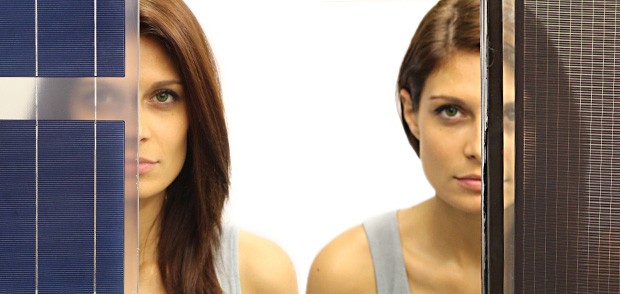Will a window one day power the building you’re sitting in?
 Left: A window comprised of spaced poly-crystalline silicon cells sandwiched between glass and a transparent back sheet. Daylight passes in between the gaps, while the window produces electricity based on the photovoltaic effect. Right: A micromorphous silicon window, which emulates fritted glass. This reduces solar heat gains and generates electricity, while providing adequate daylight and views to the outdoors. | Photo by Costa Kapsis
Left: A window comprised of spaced poly-crystalline silicon cells sandwiched between glass and a transparent back sheet. Daylight passes in between the gaps, while the window produces electricity based on the photovoltaic effect. Right: A micromorphous silicon window, which emulates fritted glass. This reduces solar heat gains and generates electricity, while providing adequate daylight and views to the outdoors. | Photo by Costa Kapsis
A window that lets sunlight in. Sounds like a pretty basic technology, right? Now imagine a window that, at the same time, generates electricity and is integrated into a smart building capable of automatically responding to minute changes in temperature both inside and outside its walls.
That is the dream of Andreas Athienitis, a professor in the Department of Building, Civil and Environmental Engineering and the scientific director of the Smart Net-Zero Energy Buildings Strategic Network, a pan-Canadian research initiative focused on making buildings capable of generating as much electricity as they consume. A key tool in this effort is photovoltaic technology: the use of semiconductors to directly convert sunlight into electrical current and heat.
“Most existing photovoltaic systems — including our demonstration project at the top of the John Molson School of Business Building — are opaque,” says Athienitis. “We’re seeking ways of making window panels that produce electricity but also let some light through like regular glass would.”
Thanks to federal funding provided through the Business-Led Networks of Centres of Excellence (BL-NCE), Concordia is getting closer to this goal.
Athienitis and his team are part of the Refined Manufacturing Acceleration Process (ReMAP) network, a business-led initiative uniting industry, universities and government with the goal of bringing new environmentally friendly products to market.
Costa Kapsis, a PhD student under the supervision of Athienitis, is conducting his doctoral research in photovoltaics.
As Kapsis notes, “Existing photovoltaic technology is not optimized for buildings.”
Instead, photovoltaic panels are typically found in large clusters, like power plants, outside of structures. “We want to create a product that is plug-and-play,” he says.
That means a photovoltaic system that could be installed in the place of an existing window, eliminating the need for major retrofitting or renovations.
Thanks to the state-of-the-art Solar Simulator-Environmental Chamber laboratory, housed in the basement of the Henry F. Hall Building, Concordia is ideally positioned to test new technologies like this one. The simulator serves as a sort of artificial sun, and placing solar panels and other materials underneath it can demonstrate their efficacy in real-world scenarios.
A smart building must be able to account for human behaviour, so Kapsis is also conducting research in what could be called a “living lab.” On the 16th floor of the Engineering, Computer Science and Visual Arts Integrated Complex, he is testing the impact of human occupancy on the indoor environment.
When somebody pulls down a blind to reduce glare from the sun, he asks, how much heat is potentially lost? By tracking countless similar actions, Kapsis can include the resulting data in his modelling, and better understand how smart technology will need to respond in order to ensure the comfort of building residents.
“I am very attracted to this technology,” he says. “My background is physics, but I also like anything related to buildings.”
And, on that front, things are looking bright.
“I am very optimistic about the future of this field.”
Check out how another Concordia graduate student is changing the way we see machines.